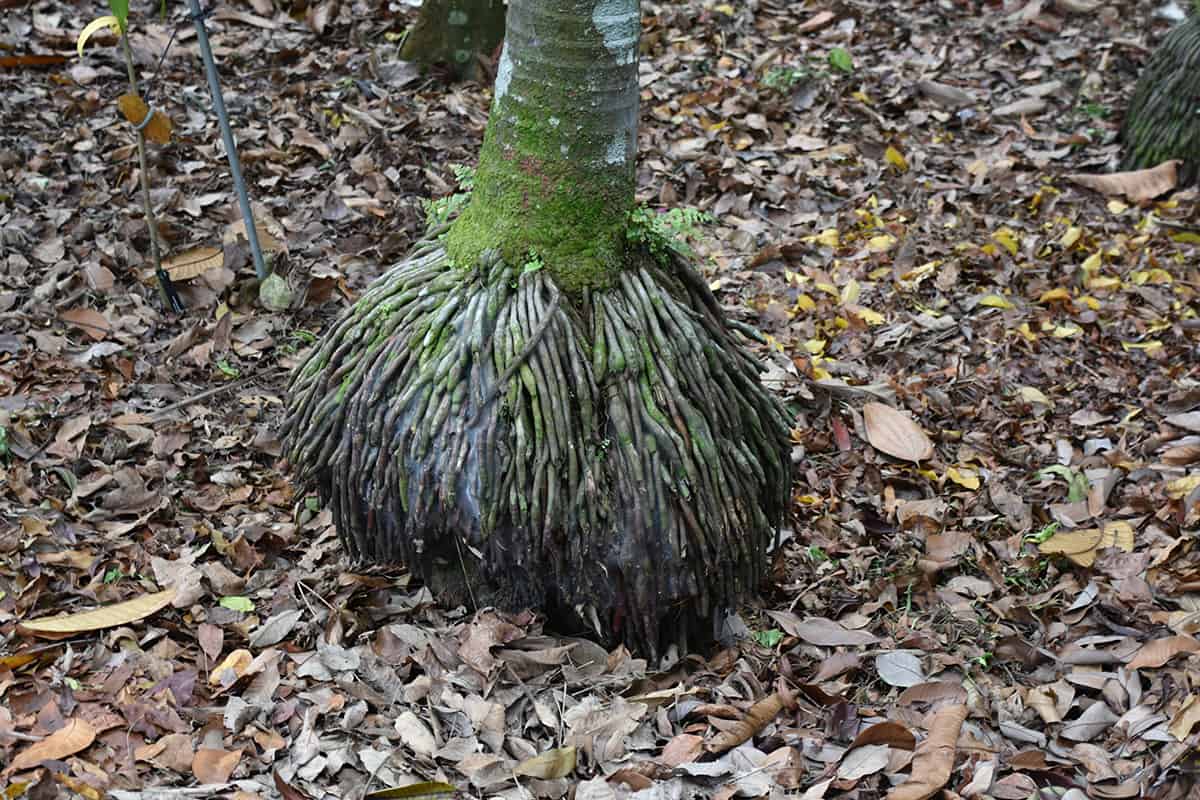Palm trees can reach exceptional heights of up to 200 feet, so you might expect that their root systems will be large and extend deep into the ground in order to anchor them. This assumption would be wrong since palm trees actually have very shallow root systems, and the size of the root ball does not necessarily correlate to the size of the tree.
The roots of a palm tree grow horizontally rather than vertically, and as a result, they remain only in the shallow soil surrounding the tree and do not grow into the deep soil. Palm tree roots will occupy a maximum depth of 3 feet.
Table of Contents
How Big Do Palm Tree Roots Get?

If you live in an area where palm trees grow in abundance, then you may have noticed that palm tree roots are often visible on top of the soil or sand where they grow. This is because rather than growing vertically downwards into the depth of the soil, they grow outwards in a horizontal direction.
The result of this is that they are growing parallel to the soil, and as such, they will often come through and make an appearance.
The root ball of palm trees needs to be large and strong in order to support the great height that these trees can reach. They commonly grow in climates that are prone to extreme storms and hurricanes, so it’s vital that the root ball is able to anchor the tree to the ground to prevent it from being torn out in high winds.
Although the roots of a palm tree will not spread down into the depths of the soil to more than 3 feet, they have an extensive root system that can spread very wide. The roots of a palm tree will commonly span a much greater width than the actual spread of the tree itself.
For example, if the canopy of a tree is 50 feet wide, you can expect the roots to be found as far as 100 feet from the trunk of the tree. Conversely, the size of a palm tree above ground does not bear any indication of the size of the root ball. In fact, in many cases, a relatively small root ball can support an extensively tall palm tree.
In terms of the girth of the roots, palm tree roots do not get very big. While other trees have roots that grow in width as they also grow in length, palm tree roots do not do this. Instead, they remain quite thin while continuing to extend further and further away from the tree in a horizontal angle.
Characteristics of Palm Tree Roots
Palm trees are technically not trees at all, and in fact, they are closer to types of grasses such as bamboo than they are to woody trees. One of the ways that this affects how palm trees develop is in regard to the roots.
While trees have tap roots, which consists of one main chunky root which grows vertically downwards, and from which other roots emerge from, palm trees do not have tap roots. Instead, they have many thinner roots, which all play equal parts in the development, growth, and life cycle of the tree.
The roots of a palm tree are fibrous, much like the trunk of the tree, which interestingly is, in fact, not a trunk at all. Since palm trees are not true trees, they do not have trunks, and instead, the part of a palm tree that we consider as a trunk is technically a stem. The stem, which heavily resembles the trunk of true trees, is not made from wood and instead is a wet, fibrous material.
When you cut into a palm tree’s stem, it will not have rings like you would see when cutting into the trunk of a regular tree, and it would be much messier to saw because of the high moisture content. It is, for this reason that palm tree stems are not as widely cultivated for their use in wood making as woody trees are because the material they produce is more like wicker or bamboo than real wood.
Purpose of Palm Tree Roots
The purpose of a palm tree’s roots is much the same as that of a true tree.
Absorb moisture

Like all plant roots, the root system of a palm tree serves the function of absorbing moisture from the soil and delivering it to the main parts of the tree to keep it healthy and hydrated. Most palm trees are reliant on generous amounts of water in order to thrive, though there are some drought-tolerant species.
Absorb nutrients
Along with absorbing moisture, the roots of a palm tree also absorb nutrients for the tree to convert into energy, allowing it to grow and produce healthy foliage, flowers, and fruits.
Although many species of palm trees are accustomed to surviving in soils that lack nutrients, they do need a certain level of minerals to keep the foliage fresh and green, and it is the roots that help to provide this to the tree.
Anchor the tree

The roots of a palm tree anchor it to the ground, providing stability so that the tree does not become uprooted in heavy winds and storms. The fibrous roots of a palm tree can bind themselves to sandy soil, which also provides an extra level of grip for the anchorage of the tree.
Palm Roots Vs. Other Tree Roots
Since palm trees are not really trees, they do not develop roots in the same way that trees do.
Depth
Palm tree roots spread out horizontally in thin strands instead of growing directly downwards like regular tree roots. This means that the roots of a palm remain in the uppermost 3 feet of soil, while true tree roots will typically extend to depths of up to 10 feet in the ground.
This makes palm trees easy to uproot and transplant because you don’t need to dig very deep to completely uncover the entirety of a palm tree’s roots. This also makes palm trees a good choice in areas where there are underground pipes or building foundations because the palm roots won’t travel deep enough into the ground to become a problem as other tree roots can.
Taproot
Palm trees do not have tap roots, while true trees do. The taproot on a tree is the main root that grows vertically down into the soil and from which most of the other roots are formed. Instead of tap roots, palm trees have a complex system of thin, lengthy roots that all share equal functions.
Girth
The girth of a palm tree’s roots is one of the most surprising things about the root system of these plants because they remain slender and strand-like for the duration of the palm’s life. While true trees have roots that get thicker, longer, and stronger as the tree grows taller, a palm tree’s roots remain thin for its whole life span.
As the tree grows taller, the roots continue growing in length, but they do not gain any girth. This is another reason why palm trees can be quite easy to uproot, and the roots can be broken without much difficulty.






